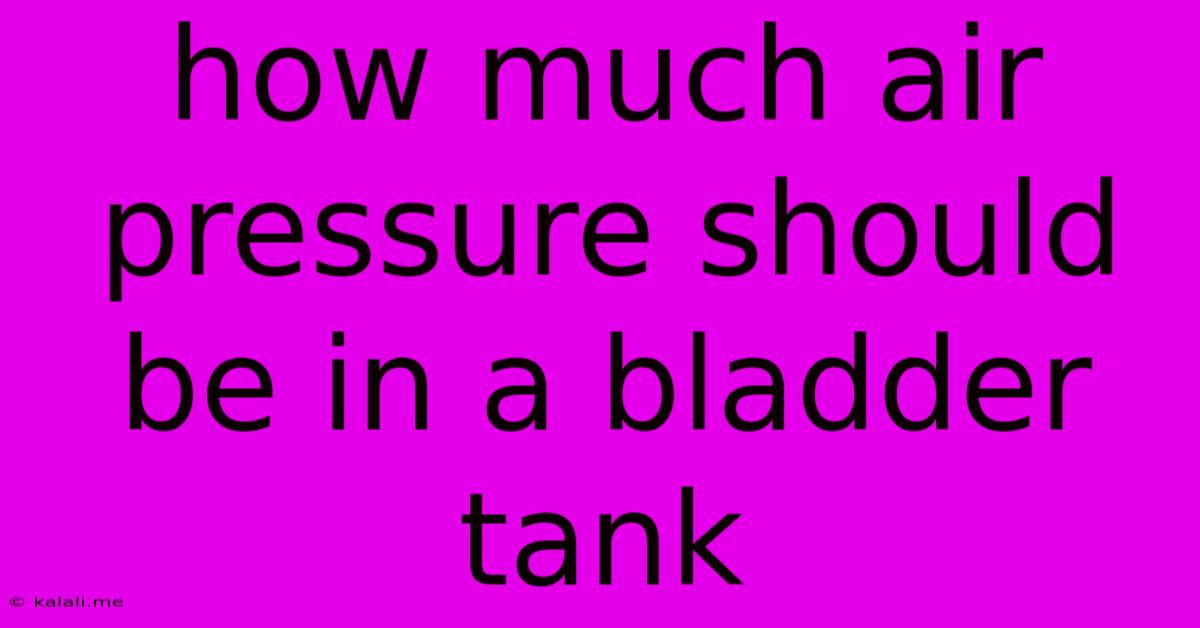How Much Air Pressure Should Be In A Bladder Tank
Kalali
May 24, 2025 · 3 min read

Table of Contents
How Much Air Pressure Should Be in a Bladder Tank? A Comprehensive Guide
Maintaining the correct air pressure in your bladder tank is crucial for its proper functioning and longevity. Incorrect pressure can lead to premature failure, inefficient operation, and even safety hazards. This guide will delve into the specifics of bladder tank pressure, helping you understand how to check and maintain the optimal level for your system.
Understanding Bladder Tanks and their Purpose
Bladder tanks are pressure vessels commonly used in water systems, primarily to mitigate the effects of water hammer and provide a consistent water pressure. They consist of a rubber bladder inside a rigid tank; the bladder is filled with water, and the surrounding space is filled with compressed air. The air pressure acts as a cushion, regulating the water pressure within the system.
Determining the Correct Air Pressure: It's Not One-Size-Fits-All
Unfortunately, there isn't a single magic number for bladder tank air pressure. The ideal pressure depends on several factors:
- System Water Pressure: The air pressure should generally be about 2 PSI lower than the water pressure in your system at its highest point. This is because the air pressure works in conjunction with water pressure to create a balanced and efficient system.
- Tank Size and Type: Larger tanks may require slightly higher pressure to maintain the same water pressure as smaller tanks. The type of bladder (e.g., butyl rubber, EPDM) can also impact the ideal pressure, though this is less significant than the other factors. Always consult the manufacturer’s specifications if available.
- Water Demand: Higher water demands may require slightly higher air pressure, although this should be adjusted carefully.
How to Check and Adjust Bladder Tank Air Pressure:
- Locate the Air Valve: This valve is usually located on the top of the tank and is often capped.
- Safety First: Before you begin, turn off the water supply to the tank. This is crucial to avoid any accidental water leakage or injury.
- Release Pressure (If Necessary): If the pressure is significantly higher than expected, carefully release some air using a pressure gauge and an appropriate fitting (like a tire pressure gauge). Do this slowly to avoid sudden pressure drops.
- Connect a Pressure Gauge: Attach a pressure gauge to the air valve. A tire pressure gauge can often be used, but a more accurate gauge is preferable.
- Measure the Pressure: Note the current air pressure reading.
- Adjust Pressure: If the pressure is too low, add air using a hand pump or air compressor until it reaches the correct level. Remember, the ideal pressure is typically 2 PSI less than the system's highest water pressure.
- Test and Monitor: Turn the water supply back on and monitor the tank's performance and pressure for a few days to confirm everything is working correctly.
Signs of Incorrect Air Pressure:
- Inconsistent Water Pressure: Fluctuations in water pressure are a strong indicator of incorrect air pressure in the bladder tank.
- Tank Noises: Unusual noises emanating from the tank, such as loud banging or gurgling, might point to pressure problems.
- Premature Wear: Incorrect pressure puts stress on the bladder and tank, potentially leading to leaks or premature failure.
Maintenance and Prevention:
Regularly checking the air pressure in your bladder tank (every few months) is crucial for its long-term performance. Addressing pressure issues early can prevent major problems down the line. Always consult the manufacturer's instructions for your specific tank.
By following these guidelines and paying attention to your system's performance, you can ensure your bladder tank operates efficiently and reliably for years to come. Remember, safety is paramount; if you're unsure about any aspect of this process, it's always best to consult a qualified professional.
Latest Posts
Latest Posts
-
Can Jets Do Sonic Booms At Airshows In Cities
May 24, 2025
-
Does Kombucha Need To Be Refrigerated
May 24, 2025
-
Which Is Better Kb Or Mb
May 24, 2025
-
How Much Does A Pornstar Earn
May 24, 2025
-
Did Pharaoh Die In The Red Sea
May 24, 2025
Related Post
Thank you for visiting our website which covers about How Much Air Pressure Should Be In A Bladder Tank . We hope the information provided has been useful to you. Feel free to contact us if you have any questions or need further assistance. See you next time and don't miss to bookmark.